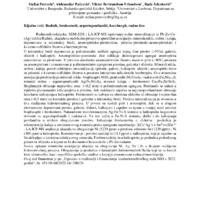Poreklo asocijacije Ni, Ag i Sn minerala u polimetaličnom ležištu Rudnik
Објеката
- Тип
- Саопштење са скупа штампано у изводу
- Верзија рада
- објављена
- Језик
- српски
- Креатор
- Stefan Petrović, Aleksandar Pačevski, Viktor Bertrandson Erlandson, Rade Jelenković
- Извор
- 18. Kongres geologa Srbije "Geologija rešava probleme", Divčibare, 01-04 jun 2022.
- Издавач
- Srpsko geološko društvo
- Датум издавања
- 2022
- Сажетак
-
Rudnomikroskopska, SEM-EDS i LA-ICP-MS ispitivanja rudne mineralizacije iz Pb-Zn-Cu-(Ag) ležišta Rudnik, ukazala su na lokalno prisustvo specifične asocijacije minerala nikla, srebra i kalaja, deponovane u tektonskoj breči, arsenopiritsko-pirotinskim, piritsko-pirotinsko-arsenopiritskim i kvarcno-sulfidnim žicama u harcburgitima.
U tektonskoj breči deponovan je polimineralni sulfidni agregat kojeg čine pirotin (50), galenit, sfalerit i halkopirit. Arsenopiritsko-pirotinske žice odlikuje dezintegrisani agregat arsenopirita cementovan sa pirotinom. U piritsko-pirotinsko-arsenopiritskim žicama masivni pirit (50%) prorasta sa arsenopiritom i cementovan je polimineralnim agregatom pirotina, galenita i sfalerita. Minerali nikla, srebra i kalaja, pored uobičajene mineralizacije (pirotin, galenit, halkopirit, sfalerit i arsenopirit) često su prisutni u kvarcno-sulfidnim žicama u prostoru intenzivno talkiziranih harcburgita. Ovu mineralnu asocijaciju predstavljaju minerali nikla - brajthauptit NiSb, pentlandit (Ni,Fe)9S8 i makinavit (Fe,Ni)1+xS; mineral srebra - argentopentlandit Ag(Fe,Ni)8S8; mineral kalaja – ferokesterit Cu2(Fe,Zn)SnS4. Brajthauptit obrazuje nepravilna zrna (0,2 mm) u polimineralnom agregatu. Pentlandit se nalazi u tipičnim plamenastim izdvajanjima u pirotinu, dok makinavit zajedno sa argentopentlanditom obrazuje lamelarna izdvajanja u halkopiritu. Ferokesterit se izdvaja na obodima sfalerita ali obrazuje i nepravilna zrna (0,5 mm) na kontaktu pirotina i galenita u tektonskoj breči. Uočena mineralizacija je stvorena u dva stadijuma hidrotermalnog procesa. U prvom su nastali pirit i arsenopirit, dok su u drugom istovremeno deponovani pirotin, galenit, sfalerit, halkopirit i zajedno sa njima u manjoj meri prisutni brajthauptit i ferokesterit. Naknadnom transformacijom Ag-Fe-Ni-S sistema u halkopiritu kogenetski stvoreni su argentopetlandit i makinavit. Na isti način u Fe-Ni-S sistemu, došlo i do izdvajanja pentlandita u niklom obogaćenom pirotinu. Izdvajanje ferokesterita u sfaleritu posledica je inkorporacije kalaja u strukturu ovog minerala preko spregnute supstitucije: 2(Cu+Ag+) + Sn4+3Zn 2+ . LA-ICP-MS analiza je ukazala na obogaćenje Ni (5239 ppm) u pirotinu, odnosno Sn (1230 ppm) i Ni (389 ppm) u halkopiritu. Konstatovan je i povišen sadržaj In (313 ppm) u halkopiritu, koji je zajedno sa Sn uklopljen u kristalnu rešetku ovog minerala. Povišen sadržaj In u halkopiritu je posledica podređenog prisustva sfalerita u kojem se In dominatno koncentriše u Pb-Zn rudama.
Sastav opisane mineralne asocijacije ukazuje na obogaćenje Ni, Ag, Sn i In u drugom stadijumu hidrotermalnog procesa. Obogaćenje je posledica višestadijnih hidrotermalnih fluida koji su se kretali kroz ultramafite, kao i specifične geološke sredine u kojoj je deponovana rudna mineralizacija. -
Ore microscopy, SEM-EDS, and LA-ICP-MS analyses of ore mineralization from the Pb-Zn-Cu-(Ag) Rudnik deposit, revealed the local presence of a specific association of nickel, silver, and tin minerals, which was deposited in tectonic breccia, arsenopyrite-pyrrhotite veins, pyrite-pyrrhotite-arsenopyrite veins and quartz-sulphide veins in harzburgites.
A polymineral sulphide aggregate of pyrrhotite (50), galena, sphalerite and chalcopyrite is located in the tectonic breccia. The arsenopyrite-pyrrhotite veins contain a disintegrated aggregate of arsenopyrite cemented with pyrrhotite. In the pyrite-pyrrhotite-arsenopyrite veins, massive pyrite (50%) intergrows with arsenopyrite and is cemented with a polymineral aggregate of pyrrhotite, galena, and sphalerite. The nickel, silver, and tin minerals are often present in quartz-sulphide veins in the space of intensely talc-altered harzburgites with the prevailing standard mineralization (pyrrhotite, galena, chalcopyrite, sphalerite, and arsenopyrite). This mineral association is represented by nickel minerals - breithauptite NiSb, pentlandite (Ni,Fe)9S8 and mackinawite (Fe,Ni)1 + xS; silver mineral - argentopentlandite Ag (Fe,Ni)8S8; tin mineral – ferrokesterite Cu2(Fe,Zn)SnS4. Breithauptite occurs as irregular grains (0.2 mm) within the polymineral aggregate. Pentlandite forms common exsolutions in pyrrhotite, whereas co-existing mackinawite and argentopentlandite forms lamellar exsolution in chalcopyrite. Exsolution of ferrokesterite is at the edges of the sphalerite but also forms irregular grains (0.5 mm) at the point of contact of pyrrhotite and galena in the tectonic breccia. The ore mineralization was formed in two stages of the hydrothermal process. In the first stage pyrite and arsenopyrite were formed, whereas pyrrhotite, galena, sphalerite, chalcopyrite with subordinate breithauptite and ferrokesterite in the second stage. Subsequent transformation of the Ag-Fe-Ni-S system in chalcopyrite, caused the simultaneous formation of argentopetlandite and mackinawite. In the same process, in the Fe-Ni-S system, flames exsolution of pentlandite in nickel-enriched pyrrhotite was formed. The formation of ferrokesterite in sphalerite is a consequence of Sn incorporation into the structure of this mineral through a coupled substitution: 2(Cu+Ag+)+Sn4+3Zn2+. LA-ICP-MS analyses indicate an enrichment of Ni (5239 ppm) in pyrrhotite, Sn (1230 ppm) and Ni (389 ppm) in chalcopyrite. Increased content of In (313 ppm) in chalcopyrite is a result of simultaneous incorporation of In with Sn into the crystal lattice of chalcopyrite. Chalcopyrite is enrichment with In, because of the subordinate presence of sphalerite like a dominant indium-bearing mineral in Pb–Zn ores.
The above-mentioned mineral association indicates the enrichment of Ni, Ag, Sn and In in the second stage of the hydrothermal process. This enrichment is a result of multistage hydrothermal fluid circulation through the ultramafics rocks, as well as the specific geological environment in which the mineralization is deposited. - почетак странице
- 197
- крај странице
- 198
- isbn
- 978-86-86053-23-7
- Subject
- Rudnik, ferokesterit, argentopentlandit, harcburgit, rudne žice
- Rudnik, ferrokesterite, argentopentlandite, harzburgite, ore veins
- Шира категорија рада
- М60
- Ужа категорија рада
- М64
- Је дио
- Ugovoru o realizaciji i finansiranju naučnoistraživačkog rada NIO u 2022. godini“, br. 451-03-68/2022-14/ 200126
- Права
- Отворени приступ
- Лиценца
- All rights reserved
- Формат
Stefan Petrović, Aleksandar Pačevski, Viktor Bertrandson Erlandson, Rade Jelenković. "Poreklo asocijacije Ni, Ag i Sn minerala u polimetaličnom ležištu Rudnik" in 18. Kongres geologa Srbije "Geologija rešava probleme", Divčibare, 01-04 jun 2022., Srpsko geološko društvo (2022) М64
This item was submitted on 8. децембар 2022. by [anonymous user] using the form “Рад у зборнику радова” on the site “Радови”: http://gabp-dl.rgf.rs/s/repo
Click here to view the collected data.
